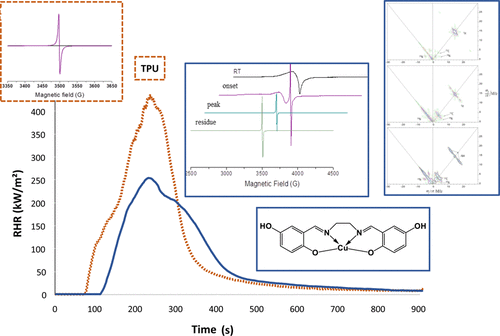当前位置:
X-MOL 学术
›
ACS Appl. Mater. Interfaces
›
论文详情
Our official English website, www.x-mol.net, welcomes your
feedback! (Note: you will need to create a separate account there.)
Salen Complexes as Fire Protective Agents for Thermoplastic Polyurethane: Deep Electron Paramagnetic Resonance Spectroscopy Investigation
ACS Applied Materials & Interfaces ( IF 8.3 ) Pub Date : 2018-06-29 00:00:00 , DOI: 10.1021/acsami.8b07323 Anil D. Naik 1 , Serge Bourbigot 1 , Séverine Bellayer 1 , Nadia Touati 2 , Karima Ben Tayeb 2 , Hervé Vezin 2 , Gaëlle Fontaine 1
ACS Applied Materials & Interfaces ( IF 8.3 ) Pub Date : 2018-06-29 00:00:00 , DOI: 10.1021/acsami.8b07323 Anil D. Naik 1 , Serge Bourbigot 1 , Séverine Bellayer 1 , Nadia Touati 2 , Karima Ben Tayeb 2 , Hervé Vezin 2 , Gaëlle Fontaine 1
Affiliation

|
The contribution of copper complexes of salen-based Schiff bases N,N′-bis(salicylidene)ethylenediamine (C1), N,N′-bis(4-hydroxysalicylidene)ethylenediamine (C2), and N,N′-bis(5-hydroxysalicylidene)ethylenediamine (C3) to the flame retardancy of thermoplastic polyurethane (TPU) is investigated in the context of minimizing the inherent flammability of TPU. Thermal and fire properties of TPU are evaluated. It is observed that fire performances vary depending upon the substitution of the salen framework. Cone calorimetry [mass loss calorimetry (MLC)] results show that, in TPU at 10 wt % loading, C2 and C3 reduce the peak of heat release rate by 46 and 50%, respectively. At high temperature, these copper complexes undergo polycondensation leading to resorcinol-type resin in the condensed phase and thus acting as intumescence reinforcing agents. C3 in TPU is particularly interesting because it delays significantly the time to ignition (MLC experiment). In addition, pyrolysis combustion flow calorimetry shows reduction in the heat release rate curve, suggesting its involvement in gas-phase action. Structural changes of copper complexes and radical formation during thermal treatment as well as their influence on fire retardancy of TPU in the condensed phase are investigated by spectroscopic studies supported by microscopic and powder diffraction studies. Electron paramagnetic resonance (EPR) spectroscopy was fully used to follow the redox changes of Cu(II) ions as well as radical formation of copper complexes/TPU formulations in their degradation pathways. Pulsed EPR technique of hyperfine sublevel correlation spectroscopy reveals evolution of the local surrounding of copper and radicals with a strong contribution of nitrogen fragments in the degradation products. Further, the spin state of radicals was investigated by the two-dimensional technique of phase-inverted echo-amplitude detected nutation experiment. Two different radicals were detected, that is, one monocarbon radical and an oxygen biradical. Thus, the EPR study permits to deeply investigate the mode of action of copper salen complexes in TPU.
中文翻译:

Salen配合物作为热塑性聚氨酯的防火剂:深电子顺磁共振光谱研究
Salen基席夫碱N,N'-双(水杨基)乙二胺(C1),N,N'-双(4-羟基水杨基)乙二胺(C2)和N,N的铜络合物的贡献在使TPU的固有可燃性最小化的背景下,研究了'-双(5-羟基水杨基)亚乙基二胺(C3)对热塑性聚氨酯(TPU)的阻燃性。评估了TPU的热和火性能。可以看出,防火性能根据Salen框架的替代情况而有所不同。锥形量热法[质量损失量热法(MLC)]结果表明,在TPU中,负载量为10 wt%时,C2和C3分别使放热率的峰值降低46%和50%。在高温下,这些铜络合物发生缩聚反应,从而在缩合相中形成间苯二酚型树脂,从而用作膨胀增强剂。TPU中的C3特别有趣,因为它会大大延迟点火时间(MLC实验)。此外,热解燃烧流量热法显示出放热速率曲线的减小,表明其参与了气相作用。通过显微镜和粉末衍射研究的光谱研究,研究了铜配合物的结构变化和热处理过程中自由基的形成,以及它们对TPU凝聚相阻燃性的影响。充分利用电子顺磁共振(EPR)光谱来跟踪Cu(II)离子的氧化还原变化以及铜配合物/ TPU制剂在其降解途径中的自由基形成。超细亚级相关光谱的脉冲EPR技术揭示了铜和自由基的局部周围环境的演化,在降解产物中氮片段的贡献很大。进一步,通过二维反相回波振幅检测章动实验研究了自由基的自旋态。检测到两个不同的自由基,即一个单碳自由基和一个氧双自由基。因此,EPR研究可以深入研究TPU中铜塞伦配合物的作用方式。
更新日期:2018-06-29
中文翻译:

Salen配合物作为热塑性聚氨酯的防火剂:深电子顺磁共振光谱研究
Salen基席夫碱N,N'-双(水杨基)乙二胺(C1),N,N'-双(4-羟基水杨基)乙二胺(C2)和N,N的铜络合物的贡献在使TPU的固有可燃性最小化的背景下,研究了'-双(5-羟基水杨基)亚乙基二胺(C3)对热塑性聚氨酯(TPU)的阻燃性。评估了TPU的热和火性能。可以看出,防火性能根据Salen框架的替代情况而有所不同。锥形量热法[质量损失量热法(MLC)]结果表明,在TPU中,负载量为10 wt%时,C2和C3分别使放热率的峰值降低46%和50%。在高温下,这些铜络合物发生缩聚反应,从而在缩合相中形成间苯二酚型树脂,从而用作膨胀增强剂。TPU中的C3特别有趣,因为它会大大延迟点火时间(MLC实验)。此外,热解燃烧流量热法显示出放热速率曲线的减小,表明其参与了气相作用。通过显微镜和粉末衍射研究的光谱研究,研究了铜配合物的结构变化和热处理过程中自由基的形成,以及它们对TPU凝聚相阻燃性的影响。充分利用电子顺磁共振(EPR)光谱来跟踪Cu(II)离子的氧化还原变化以及铜配合物/ TPU制剂在其降解途径中的自由基形成。超细亚级相关光谱的脉冲EPR技术揭示了铜和自由基的局部周围环境的演化,在降解产物中氮片段的贡献很大。进一步,通过二维反相回波振幅检测章动实验研究了自由基的自旋态。检测到两个不同的自由基,即一个单碳自由基和一个氧双自由基。因此,EPR研究可以深入研究TPU中铜塞伦配合物的作用方式。









































 京公网安备 11010802027423号
京公网安备 11010802027423号